Cinerama, David Strohmaier and the "We have all seen it as a kid" thing |
Read more at in70mm.com The 70mm Newsletter |
| Interviewed and photographed by: Thomas Hauerslev in Copenhagen, 25. October 2015 | Date: 31.10.2015 |
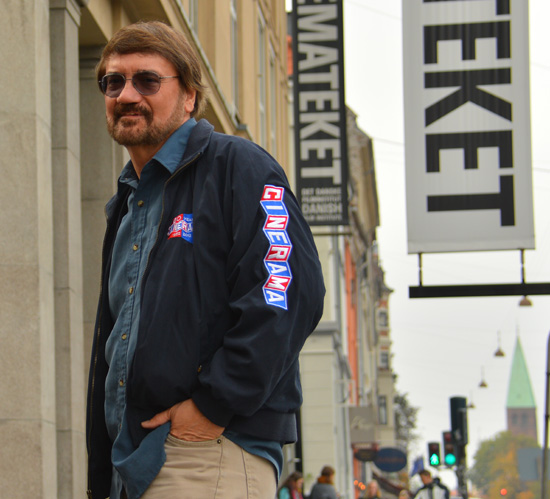 Dave
Strohmaier October 25th, outside the Cinematek in Copenhagen, Denmark Dave
Strohmaier October 25th, outside the Cinematek in Copenhagen, DenmarkHow did you become interested in Cinerama? Just seeing it as a child back in 1957. It was with "Seven Wonders of the World" on a family vacation to St. Louis. We saw the Cinerama theatre and everyone in those days knew what Cinerama was. Even if you had never seen it. It was kind of a household word, it was so popular, and so we went to see "Seven Wonders of the World". It was an interesting and very unique movie experience, because....I may have seen one or two movie before that. I don't know what, but seeing that in the widescreen format was kind of mind boggling. That is probably why Cinerama lasted so long, because it was so different. Not only did it create a wide screen in the cinema, but it was different on its own right, and people felt they were moving with the theatre. I remember people oohing and awing when the camera would bank from one side to the other or go around a mountain. And we were in the cheap seats. We were in the balcony and we were holding on to our seats too. Even thought we probably did not have the beast seats in town, because my dad wouldn't spend that kind of money for the show, we got quite an impression, and it stayed with me and my sister, who is two years older than me. She remembers it to this day. The time we went to St. Louis to see "Seven Wonders of the World", so.... How did it come about that you have been working with Cinerama films for the past 15 years? It probably came about inadvertently when I was working on that documentary inspired by what John Harvey was doing. He had revived it, because at the time nobody could see this again, it was gone, it was over with and dead. Even Lowell Thomas thought it would cost millions of dollars just to reactivate it, and he even talked about doing Cinerama in 1976 for the 200th anniversary of America. He wanted to revive the flight across America, and take it to different cities and show it in Cinerama. But in one of his books, he said something about it would cost millions of dollars to do, and who knows if we can even do it, where the film is and that kind of stuff. So it was talked about in one point. Because of the John Harvey revival, I was going out to make a half-hour documentary on the guy who invented Cinerama and the guy who revived it. Paralleling each other a little bit. Make a little documentary about that, and I realized there was a bigger story than just a guy in Ohio. Nothing against that, he was certainly a real hero, but I had to think economically. How could I sell this and keep Cinerama alive. So I just made this feature documentary "Cinerama Adventure", shut down my life for a year and a half, interviewed tons of people, made the film. Eventually, it got done. The Cinerama people gave me the rights to use anything I wanted for a dollar. Then I got Roger Mayer involved, the head of Turner Entertainment at the time, and he said "Well, we'll give you the clips from "How the West Was Won" for a dollar", and suddenly everybody around town was cooperating. The American Society of Cinematographers came in, Randy Gitsch came on board as the producer and many people were volunteering to do stuff, I kept staying out of editing work to finish it. I don’t start something and not finish it. And then after the documentary is over, where everything theoretically should have ended and I would go on with the rest of my life, I wanted to go back to editing. I would go back to do a few shows here and there. And little by little there became kind of a need by 2002 for the 50th anniversary of Cinerama to make a new print, and I got involved in that. The new print of "How the West Was Won" I got involved in that. Then it was "Should these things come out on DVD or something"? Little by little I got some financing from the Cinerama company to do "Windjammer" and “This Is Cinerama” which were the first two releases that came out. They were kind of substandard in a way, because we only had so much money to work with. Now things are cheaper to do. Back then they were not, you could not scan film without paying a lot per frame. We did it the telecine route to try to get it to equal a 2K file, but still, the films had lots of defects in them. We cleaned up as best as we could and eventually they came out. |
More in 70mm reading: The 2015 European Cinerama Festival Tour Interview with producer Randy Gitsch in70mm.com's Cinerama page Cinerama Remaster in70mm.com's "Windjammer" in Cinemiracle page Dave Strohmaier Dave Strohmaier and Randy Gitsch - in conversation with Mark Lyndon Mike Todd Jr.'s "Scent of Mystery" in Smell-O-Vision Internet link: flickeralley.com borisfx.com #1 borisfx.com #2 “I was very much surprised by the results,” commented Strohmaier. “BCC Flicker Fixer was quite fast and did more than just cure the flicker. The filter also succeeded in removing the emulsion blotching that occurred due to the age of the film – as well as the artifacting in the scanned negative. By setting the Temporal Smoothing value to 1, BCC Flicker Fixer removed all of the flicker as well as the emulsion blotching that appeared in different panels of the three way scan,” continued Strohmaier. “The process was so successful that I have gone back into two productions that were finished and applied BCC Flicker Fixer to several previously un-fixable shots.”
|
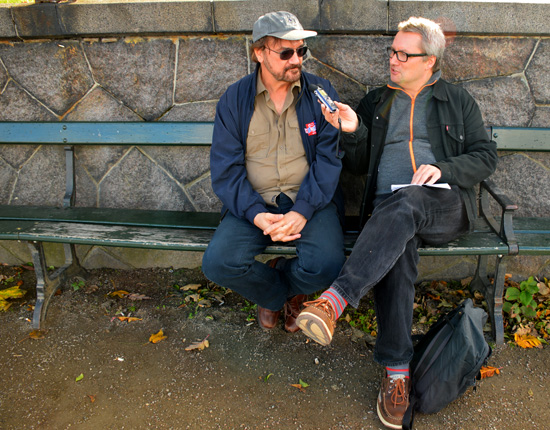 Dave
Strohmaier talking about Cinerama on a public park bench in Copenhagen,
Denmark. Image by Randy Gitsch Dave
Strohmaier talking about Cinerama on a public park bench in Copenhagen,
Denmark. Image by Randy GitschLittle by little they put more money into it because of the 60th anniversary coming up. Then I got involved with that and convinced Image Trends to do it for very little money and amazingly they agreed to it, because they all had seen it as kids as well. You have to play on that "We have all seen it as a kid" thing, and you can get some real discounts. So you know, that's how that works. What does it mean when a film is lost? Well, most people believed "Holiday in Spain" was lost, or "Scent of Mystery". The others they kind of knew the negative existed in some shape or form. The "Russian Adventure" was thought to be lost as well, but they were with some difficulty both found. "Russian Adventure" in particular, was found in an old warehouse, and we had to rescue it actually. A film is lost means you will never ever see it, so you can't say these are lost film any more. They are re-discovered, and they are all reconstructed and remastered and restored. Explain the difference between remastering, reconstructing and restoring movies Reconstruction is finding all the elements and put it them back together again because they are all scattered. You are reconstructing something that technically does not exist in any master form anywhere, any negative or anything. Such is the case of "Holiday in Spain" where we had the negative, but where most of it was damaged and we could only use parts of it so we had to go up the prints. That is what I call "we are reconstructing it", like a jigsaw puzzle. You are putting it back together again. Remastering is just taking something that already exist, and cleaning it up, fixing it up, and making it look a little bit better, but it is not a real restoration. A restoration is when you can go back to the original elements, like the camera negative, and you can clean it up as best as you can, and you are not really necessarily reconstructing it. The Cinerama things were never really that easy. Everything was a reconstruction, a remaster and a restoration, most notably the four travelogues. Five now including "This is Cinerama" which we have just done over again. So those are restorations, reconstructions and remasterings. What reactions hove you gotten from your peers in the film restoration community - if any? Not much, except for one guy who is in charge of one of the major studios library restorations. He seems to be pretty amazed about what we are able to do with very little money and the terrible condition of the negs. The other studios they don't pay any attention to it, essentially. We are not worried about that because what ends up, is the work you have done is going to survive. It does not matter who likes it or does not like it. Like the people who don't like SmileBox. They don't get it, or get that that’s what the director INTENDED!. So we are supposed to go out and do something the director doesn't intend? "I see, that's what you want, huh? You want straight letterbox, so you will be happy, but the original director’s would not be happy. So who should be happy here?" I love those people. I love to have that argument actually. |
|
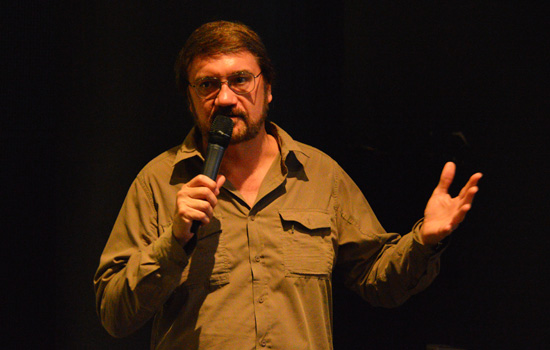 Dave
Strohmaier talking about Cinerama at the Cinematek in Copenhagen,
Denmark Dave
Strohmaier talking about Cinerama at the Cinematek in Copenhagen,
DenmarkAs far as somebody in the industry, who does restorations professionally, giving us any kind of pat on the back. It hasn't happened just yet. Which is a little interesting, because they never had to deal with 3-panel. When Warner Brothers - who did a great job on "How the West Was Won", no question there - but their negative was PRISTINE! When someone says "How do you know Dave? Because I saw it". I was with the negative cutter when they were recutting it from the IB Tech version to the - someone would say - AutoSelect version, which is a way they used to cut negatives to get to the IB Tech process. I was with Moe Henry, whose dad was the original negative cutter on "How the West Was Won", so I know what the condition of that film was. "West" was only printed about 6 times, but not much, because IB Tech has it's own new master for printing, the matrices and all that. As far as the industry itself, the restoration industry we may get recognized some day. Its interesting but you know, Many only have to deal with one frame. I'd love to do anything with one frame. Would that not be wonderful instead of trying to make three work together [laugh]? I assume that would be reasonably easy compared to Cinerama. [more laughs]. The SmileBox process follows in the foot steps of rectified Ultra Panavision 70 and the Todd-AO Distortion Correcting Printing Process - how does SmileBox works? SmileBox is done in various forms. You can go into [Autodesk] Maya, which is a software program, but you can also do it in [Adobe] After Effects, and we can adapt it to fit certain theatres if there is a budget for it. It is about a two-day operation to do one movie. For example at Bradford on their curved screen, because they have a keystone where their projector aims slightly down, it gets a little awkward, so we can fit it to that screen, by then taking a picture of that screen from the port where the light shoots through. If they take a picture of it then I can pull and stretch to make the picture fit that same screen. Other than that, if it was in the film days with 70mm. you would be putting an aperture plate in it that would be filed to a point where it is cropping stuff in the middle, they used to call those "butterfly" plates. We don’t have to crop anything with SmileBox. We can make it fit the screen by just manipulating the image, and it comes out for example like an horizon on the bottom. When I create it, it's gotta bend at the bottom - when it hits the screen, it's completely horizontal, so it does its own correction on the curved screen, depending on the curvature on the screen. SmileBox was invented by taking photographs of the Seattle 146 degree screen, the Dome 120 degree screen, and we were able to use that as a template and then we would create something on digital and take it there and show it and see what future corrections we would need to make. So we have settings for the Dome theatre, we have settings for Bradford, so any time they would request a DCP digital file, we can give them something that fits their screen. Normally SmileBox would be as if you are like in the 8th to 10th row from the screen, and you were just looking straight at the screen. That's what the normal SmileBox is, and if you have normal projection and not too much of a keystone you can play it on your flat screen, or your curved screen, and it should fit fine. It is the key-stone that messes everything up, just like it did in Todd-AO. It's really an illusion of a curved screen on a flat screen, and it works on a curved screen too. Our main template, the one that goes out on Bluray, is set for the average person at the average theatre with a flat screen and/or slightly curved screen. That way it gets broader distribution. Only at specialized areas do we have to do anything different, like The Cinerama Dome. |
|
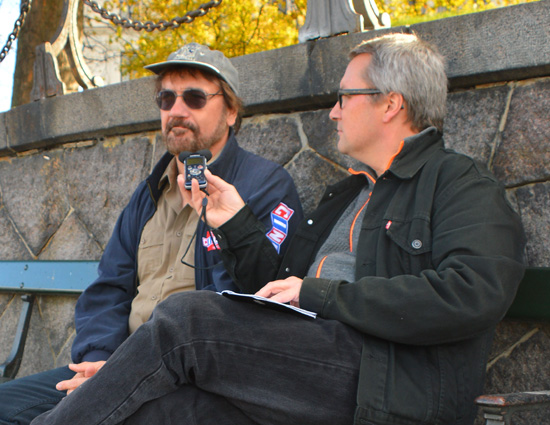 Dave
Strohmaier talking about Cinerama on a public park bench in Copenhagen,
Denmark. Image by Randy Gitsch Dave
Strohmaier talking about Cinerama on a public park bench in Copenhagen,
Denmark. Image by Randy GitschCan any film be SmileBoxed in principle? Yes, you can run any of those original Cinerama 70mm shows, in fact they will look better if you have say - name a 70mm movie - "2OO1" for example. If you project that in 70mm on a deeply curved screen you would have to do some cropping. Would Stanley like that, you know? Well, he must have approved it. He probably framed up everything so it shouldn't matter, but sometimes on some films you see the titles getting a little close to the bottom masking or the top. But we can rectify that so you are seeing the whole image, and it comes out STRAIGHT! [smiles] Not crocked or bent or horizon sag. It corrects for everything. What has been the most memorable thing reconstructing all the 3-strip films for you When you make something work that shouldn't. A software company developed something called BCC Flicker Fixer. Boris FX, if anybody in the editing business who listens, they will know who Boris FX, the company is. I tried to get rid of some bad something flicker in "Seven Wonders" as an accident. I put the wrong filter on, and it ended up doing something incredible, cleaning up many blotches. The Boris people wanted to find out about it so I even wrote an article about it. They came to my house and took pictures, that this filter wasn't supposed to do that, but it works perfectly - so the Boris FX people have helped restore 3-panel films. So we got a little publicity out of that. That was kind of rewarding. And to see these things that shouldn't really exist anymore. "Seven Wonders" had 20 minutes of negative missing, the first 20 minutes to be exact. I guess the film fell off the truck somewhere or got lost in a lab. No one knows where it ended up, however the Library of Congress cooperating with us fully, and they don't normally get involved in things like this, but they saw the historical need for it, and so we had carte blanche in borrowing anything we needed to from the Library of Congress - which means faded pinkish prints again. And then rebuilding the color back into them. We scanned the faded prints, and then rebuilt the color back into them with new techniques to try to even out the movie, so it looks like it is complete. And it is. It is complete now. It is the original film you saw in 1956, either from a original print or an original negative. What has been the most surprising discovery with your work? I suppose that things comes out of the wood work. If someone hears you are working on something they somehow contact you. The beauty of the Internet I guess. When we shot that little 1950s style short in Cinerama ["In the Picture"] using the original Cinerama camera, a guy from back east said he had a camera manual, that was written by the original camera guy Harry Squire. They sent it out to us with some drawings and stuff like that which helped the engineers put that camera back together again and helped them realise that the focus knob didn’t really means "Focus" - it means something else with alignments. You know that drove all the DPs crazy. Unusual stuff like that, like what are the chances...? It's like you are digging up a Pharaohs tomb or something, and all of a sudden, there is a map to where all the treasure is hidden. It's just things coming together out of nowhere. What will happen to all the negatives and sound elements when you are finished with your work? The sound elements and negatives go to the Academy of Arts and Sciences in Hollywood, including "Russian Adventure". So everything will go over there. Currently we are physically done with everything but "Russian Adventure" and "Windjammer" and we are going back to visit those two and finalize them. Then everything goes to the Academy |
|
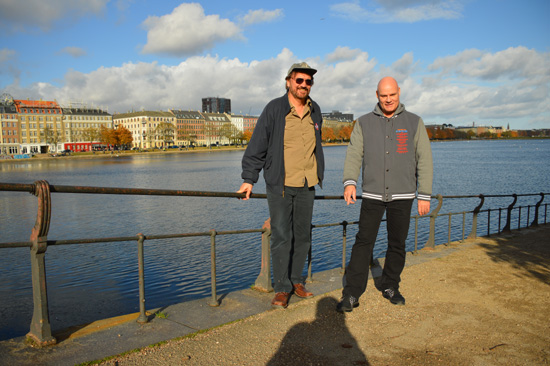 Dave
Strohmaier and producer of the Cinerama remasters Randy Gitsch beside the
lakes in Copenhagen, Denmark. Note the traditional "Cinerama Camera"
shadow. Dave
Strohmaier and producer of the Cinerama remasters Randy Gitsch beside the
lakes in Copenhagen, Denmark. Note the traditional "Cinerama Camera"
shadow.Does reviewing all the films here in Copenhagen make you want to go back to fix some things? I think you always get that, every film maker ... not that I am a film maker really, but every film maker that sees a movie 20 years later and they cringe half way through the movie and wish "I had gone back the next day to do that pick up or edit the scene differently". And I see things every day when we run these things. You see something and say "Why didn't I fix that?". No one else sees that, but I see it, and "I guess I could have adjusted that a little bit more". We did go back and adjusted a few things when we were making DCPs. It was our second run-around so, as the DCPs were being made by Tom March we generated a new version of the files, but we still have all the original files, even in the crude unrestored form, and we can go back and fix a few things. The DCPs are basically everything that should be there. The Blu-rays came out with a few minor defects in them, but they are not major at all. Why do you think Cinerama is till fondly remembered by so many people today? Well, I don’t know. It's that childhood thing again I guess. People saw it years ago, and then they remembered it, and now they can see it again, and people often say to us at the end of a screening "Gosh, I never thught I'd ever see this again" kind of thing, you know. Because it does seem impossible when you think about it with three panels, putting them back together again. If you were to go to a major post house with this job, and you had lots of money to do this big bucks, it would cost you 500-800.000 dollars a title to do it not more. And we are doing each title for 36-40.000 dollars each. Do you have a favourite among all the 3-strip films? Probably "Seven Wonders" just because it is an emotional thing, the first one I saw you know. And "How the West Was Won" because that was the last one I saw as a child If someone wants to show these titles in a cinema, how is this done? You can contact Flicker Alley, or in the case of "Holiday in Spain", that would be Redwind Productions, they went with a different company on that one, and I am sure the rest of them are going to go out with Flicker Alley. Contact them and get the rights to show them. I don't know what it will cost. If they do it and combine it with a show about restoration or talk, then it is free. We bring the film, but then they have to buy either the plane ticket or the hotel or something to get us here, and then they can have more of an interaction with the people who worked on the films restoration and the films history It's been a sort of a detour in my career in a lot of ways. Some of it good, some of it bad, but as my wife always says, "Well it's dirty work, but somebody's got to do it". |
|
| Go: back - top - back issues - news index Updated 22-01-25 |
